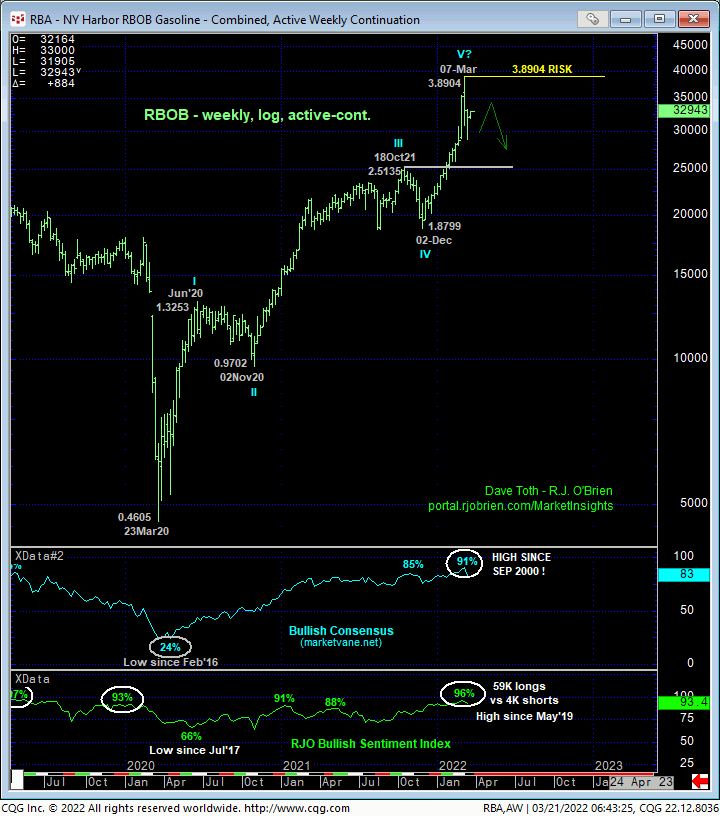
APR HEATING OL
In 15-Mar’s Technical Blog we identified 11-Mar’s 3.5229 smaller-degree corrective high as the level the market needed to sustain losses below in order to maintain a more immediate bearish count. The market’s failure to sustain loses below this level confirms a bullish divergence in short-term momentum and exposes at least the expected B- or 2nd-Wave corrective rebuttal to the sell-off attempt from 09-Mar’s 4.6709 high and possibly a (5th-Wave) resumption of the secular bull trend. This bullish divergence in momentum clearly defines 15-Mar’s 2.9330 low as one of developing importance and our new short-term risk parameter from which non-bearish decisions like short-covers and bullish punts can once again be objectively based and managed.
“Theoretically” (for what this is worth), it’s notable that the swoon from 09-Mar’s 4.6709 high to last week’s 2.9330 low looks to be only a 3-wave structure as labeled in the 240-min chart below. If we would/could rely on Elliott theory, we would conclude that 2.9330 low as the end or lower boundary of a correction ahead of a resumption of the secular bull trend. But we do not. Rather, we fully acknowledge the prospect of a 5th-Wave resumption of the secular bull trend due to, quite frankly, the dominant magnitude of this trend, If such a bullish count is wrong and if this month’s break is the initial (A- or 1st-Wave) start to a major correction or reversal lower, then by definition this current recovery attempt must 1) be stemmed by another bearish divergence in momentum from 2) a level shy of 09-Mar’s 4.6709 high in what looks to be a 3) 3-wave corrective structure. It is for exactly these reasons and the typical correction-vs-reversal debate and challenge that the third of our three key reversal requirements exists:
- a confirmed bearish divergence in momentum of a scale sufficient to break or threaten the major trend
- proof of trendy, impulsive 5-wave behavior on the initial counter-trend sell-off attempt
- proof of labored, corrective 3-wave behavior on a subsequent recovery attempt.
Against the backdrop of the secular bull market, it remains debatable whether even the first of these three reversal requirements has been met. But as we discussed, the forces behind such a mammoth bull move are unlikely to evaporate quickly, but rather over a period of time where often times corrective recoveries/retests of the high are extensive in terms of price retracement and time. Minimally, this is what we believe the recovery from last week’s 2.9330 low is. At most, it’s a resumption of the secular bull market to new highs above 4.6709. We will, of course, be watchful for a recovery-stemming bearish divergence in momentum from the upper-third of this month’s range that might tip the directional scales back in favor of a bearish count or at least defer a more immediate bullish count.
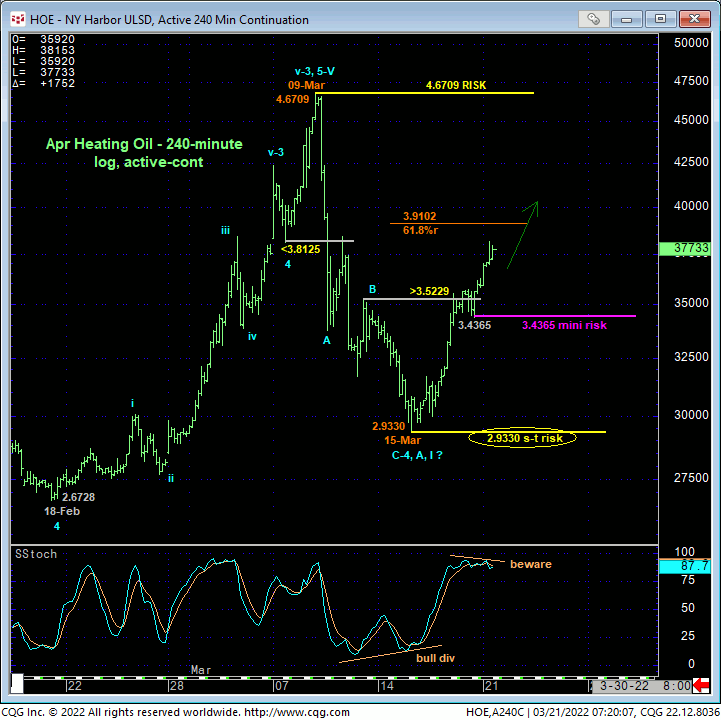
Stepping back and while no one would dispute the developing importance and clarity of the market’s definition of last week’s 2.9330 low and 09-MNar’s 4.6709 high as the key technical flexion points heading forward, the current challenge is the market’s position pretty much smack in the middle of these two range boundaries where the risk/reward merits of initiating directional exposure are poor due to the greater odds of aimless whipsaw risk typical of such range-center conditions. At least the intermediate-term trend is clearly up, with a failure below a minor corrective low from Fri morning at 3.4365 required to confirm a bearish divergence in very short-term momentum and arrest this recovery. For those willing to take a directional stand under these conditions, we believe it should be from the bull side with a failure below 3.4365 required to negate this specific all and warrant its cover ahead of further unknown intra-range behavior laterally-to-lower.
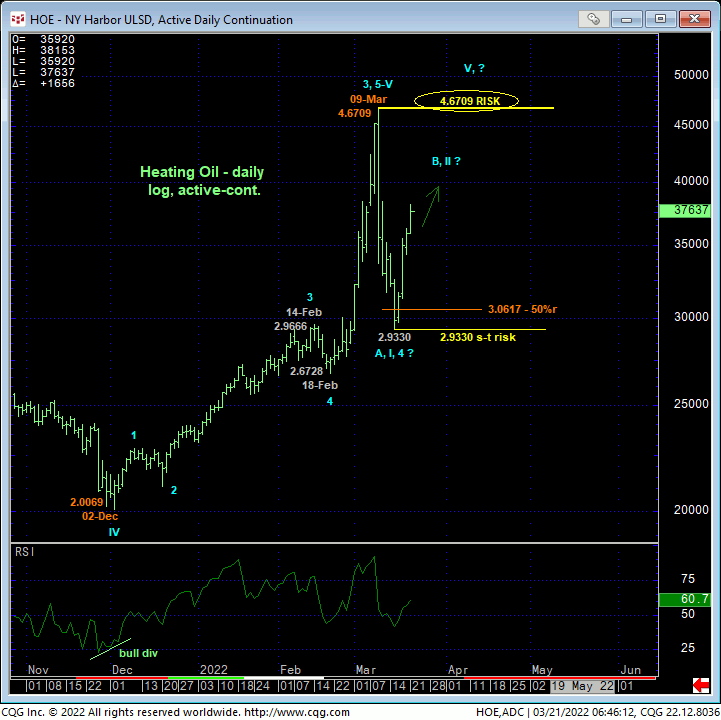
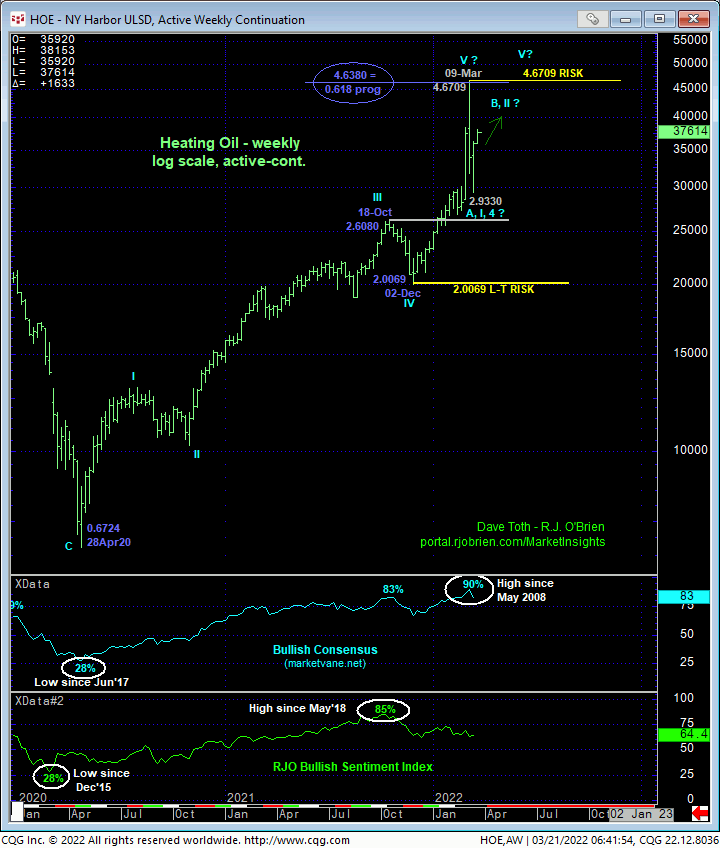
From a much longer-term perspective, historically frothy levels in the bullish Consensus (marketvane.net) measure of market sentiment/contrary opinion are typical of major peak/reversal environments once the clear and present uptrend has at least been threatened, let alone broken. And herein lies the rub: on a weekly log scale high-low basis above, the extent of mid-Mar’s setback is hard to ignore as a threat to the secular bull. Given extraordinarily high volatility however, on a weekly log close-only basis below that clears away some of the intra-week volatility “noise”, the secular bull trend looks as healthy as ever.
These issues considered, the correction-vs-reversal debate, dilemma and challenge from 09-Mar’s 4.6709 intra-day day remains. Traders are advised to acknowledge and prepare for either directional outcome. The market’s current position in the middle of the 4.6709 – 2.9330-range presents risk/reward challenges unless one tightens up risk assumption and accepts whipsaw risk below a “tight” corrective low and mini risk parameter like Fri’s 3.4365 minor corrective low. A neutral-to-cautiously-bullish policy is advised with a failure below 3.4365 required to negate this specific call and warrant its cover. In lieu of such weakness, further and possibly accelerated gains should not surprise.
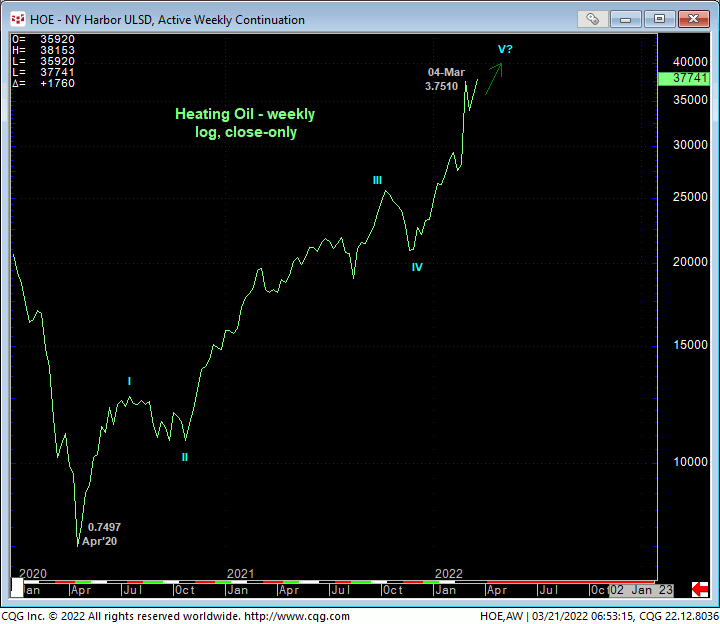
APR RBOB
Outside of the observation that this month’s sell-off attempt from 07-Mar’s 3.8904 high to last week’s 2.8861 low looks to be a 5-wave affair rather than the 3-wave-looking structure of the analogous heating oil decline, the technical construct of this market is the same as that detailed above in diesel following this morning’s recovery above last Mon’s 3.3250 corrective high and short-term risk parameter. This bullish divergence in short-term momentum breaks the decline from 3.8904 and exposes at least a BV- or 2nd-Wave correction of this decline and possibly the 5th-Wave resumption of the secular bull market. If the former, bearish count is what the market has in mind, we would/should expect a recovery-stemming bearish divergence in short-term mo from some level shy of 3.8904, perhaps around the neighborhood of the (3.5068) 61.8% retrace of this month’s setback. Until and unless such a mo failure stems this recovery, further and possibly accelerated gains are anticipated.
The 240-min chart below also shows a very minor corrective low from Fri at 3.1550. This is the level this market is now required to sustain gains above to maintain a more immediate bullish count. Its failure to do so will confirm a bearish divergence in very short-term momentum, arrest the rebound and possibly resurrect or reinforce a broader peak/reversal threat. Per such, we’re defining 3.1550 as a mini risk parameter from which cautious bullish decisions can be objectively based and managed, acknowledging the greater odds of aimless whipsaw risk typical of current range-center conditions.
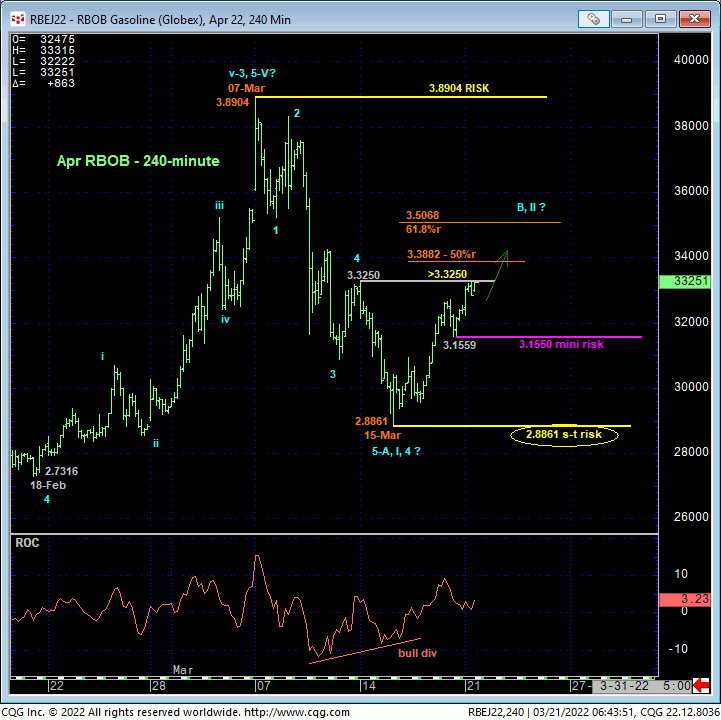
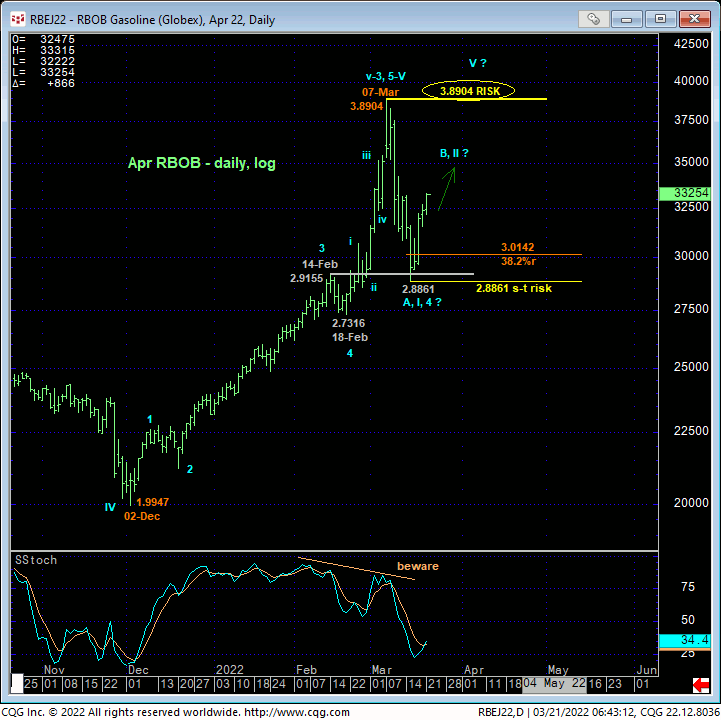
On a broader scale and just like with diesel, it remains easily debatable whether the recent sell-off attempt is sufficient to threaten the secular bull market. With historically frothy sentiment levels typical of major peak/reversal-threat environments, we certainly cannot ignore the prospect for a developing top that could be major in scope. But to CONCLUDE such at this juncture would be premature. These issues considered, a neutral-to-cautiously-bullish policy is advised with a failure below 3.1550 deferring or threatening this call enough to warrant moving to the sidelines. In lieu of such weakness, further and possibly accelerated gains should not surprise, including a run at and possibly through 07-Mar’s 3.8904 high.
